How we searched for Mars 3
Honestly, it happened almost by accident that such news came in early April and Cosmonautics Day. Today I will talk about how the story, which began and ended more than 40 years ago, suddenly got a continuation in our days. About how a simple username in contact came to NASA in his interest in Mars. The fact that the international solidarity of scientists is not an empty phrase. And that space is closer than it seems.
We were looking for Mars 3 .
And we found him! Right on Mars, at the bottom of the giant Ptolemy crater, among lifeless wastelands and boulders.
About how we did this, today's story.
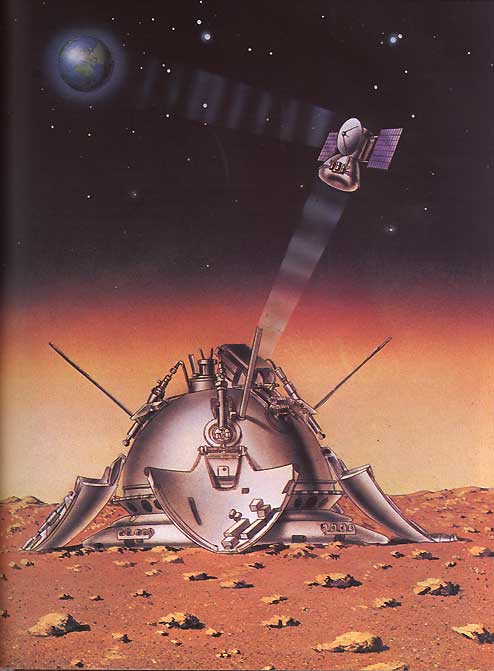
It all started on Habré ...
No, it began, of course, on May 28, far 1971, when the Soviet research station Mars-3 started to Mars. But for me personally, it all started on Habré in late November 2012, with one half-joking comment about NASA: “They found the old Soviet rover there ...” At that time, I was sure that all the “old rovers” were found long ago, because the places of their landings are known. But to test my knowledge, I went to the HiRise websiteand was surprised to learn that nothing was found! That is, the location of all successful devices is known, and they are all photographed by a HiRise camera on the NASA Mars Reconnaissance Orbiter satellite with a detail of 30 cm per pixel. But the situation with fails is not so clear. The Americans dropped Mars Polar Lander on Mars, the Europeans dropped Beagle 2, the USSR dropped Mars-6 and Mars-2, and none of this was found, although they were looking for it. But what about Mars-3? It turned out that no one had seen him either.
Our device, which made a phenomenal, first-ever successful landing on Mars 40-odd years ago! He proved that it was real, and he did it in almost the same sequence in which in 2012 the Americans put Curiosity. In general, see for yourself:
( I love this video. After all, they could launch a ship and make a movie )
So, Mars-3 sat successfully - this is known for sure, because he began the broadcast, and it is impossible without the antennas that have opened. But after 14 seconds, the radio broadcast was interrupted, leaving a puzzle for the designers about the reasons for the shutdown, and the first photograph of Mars in history was given to space and Photoshop enthusiasts.
What they just didn’t do with it, what filters they didn’t apply, just to play along with your imagination and examine the horizon, mountain slopes and Martian clouds or clouds of dust from the storm that was raging then.
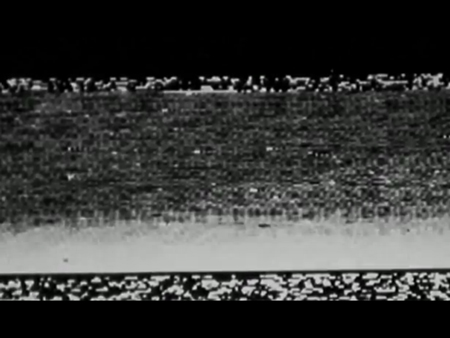
But the whole trick is that it is part of the photo panorama, and to view it from the angle that the camera shot, this frame must be rotated 90 degrees. According to the designers, the photo should have turned out like this:
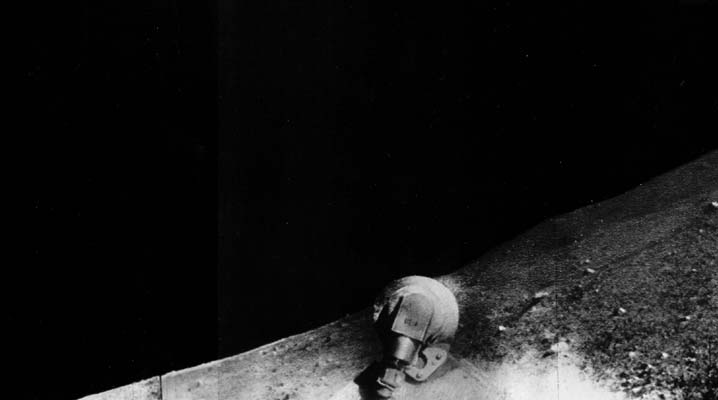
( This is a shot from the Moon-9, which has a lot in common with Mars-3 )
That is if you superimpose one on the other, it will look like this:
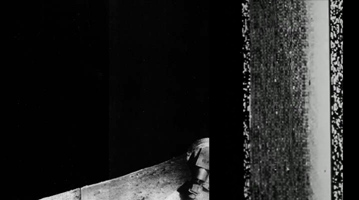
In general, valuable information was not transmitted from the surface, the first Mars rover did not set foot on the surface of Mars, because fastened to the top of the module, but a psychological victory was achieved - they first planted their device on another planet! The reason for the shutdown was not determined. Someone suggests a corona discharge in the antennas and sins in a storm, someone suspects a battery. In general, future settlers will have something to do.
Then there were other expeditions, other successes and failures, and the metal “flower” gradually went into oblivion. Generations and states have changed, the Internet, Habr and vkontakt appeared. And my interest in Mars-3 appeared.
Turning to the HiRise website, I only found a 2007 shot called Center of Soviet Mars 3 Landing Ellipse . This was a discovery for me, because I was so sure of the omnipotence of NASA and HIRise that I expected to see the exact indication of where our station was. A cursory search on the net also failed. Those. it was obvious that Mars-3 was never found. I downloaded a full-size snapshot (1.3 GB), opened it and realized why no one had found the station in 5 years.
Imagine a search on a 6 by 20 rectangle of a rounded object 1.5 meters wide. I know that many people now thought that it was necessary to write a program that would itself be looking for a station. But I think such a search is impossible until artificial intelligence is created. Yes, the program could highlight interesting boulders of the appropriate size.
But there are thousands of such objects, since there is a crater nearby, from which the rock scattered like a fan.

2 billion pixels, among which you need to find an 8 by 8 pixel object.
Here is a fragment in its original size:

I looked at the volumes of work and realized that there is no way to do without a collective mind. By then, in the VK group " Curiosity - Mars rover"there were already about 4 thousand people, and I suggested the subscribers a space-patriotic quest: find Mars-3. To do this, I cut a large photo into 20 strips, uploaded them to the network and invited everyone to participate in the search. More than a dozen enthusiasts responded they began to view the pieces and loaded into a separate album, the most interesting findings was found a lot of curious, but not an exact match showed none:.
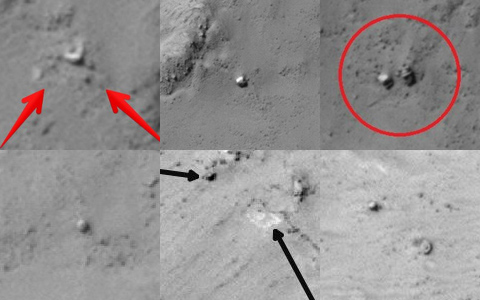
Thanks to its location and shape of the object in the lower right corner with some confidence can be called bremsstrahlung cone or at NASA terminology - the heat shield agreed with it, and the Americans with the caveat "best candidate we still did not find" He was found two members of the search:.. a reply zaero Ya andAku Neko .
As soon as we started searching, people were found more sophisticated in googling and they quickly found a link on the forum "Cosmonautics News" topic, in which the user Imhotep posted a fragment of the picture, which, most likely, shows the parachute of Mars-3.
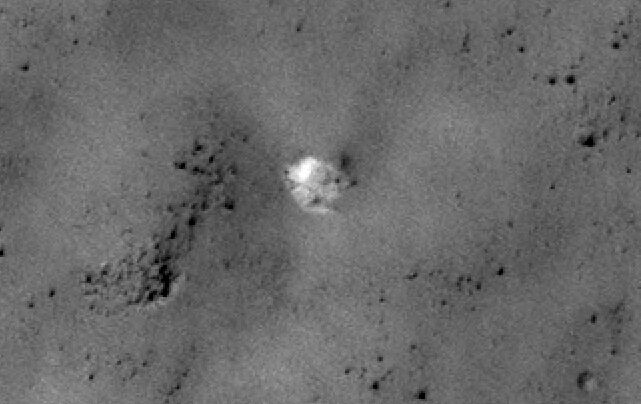 .
.
But we finished viewing the entire field of the image, but Mars-3 itself was never found. For verification, I placed all the interesting finds on a small-scale map to understand if there is any connection between them. And almost everything is past. Only the parachute and the brake cone coincided relatively, but then I did not attach any importance to this.
Then I decided to "dance from the stove" and concentrate on the parachute. That is, I took as a basis the hypothesis that it is he who is. The problem with the searches was that I did not know to what radius the structural elements could fly. Therefore, I took materials on American missions: Viking-1-2, Phoenix Lander, Mars Pathfinder, put on the landing site of Mars-3 and plotted the maximum radius to which NASA devices flew from my parachute. I brought out the most interesting objects to a separate scheme, where I placed them in approximate accordance with their position on the ground. The result was this picture:
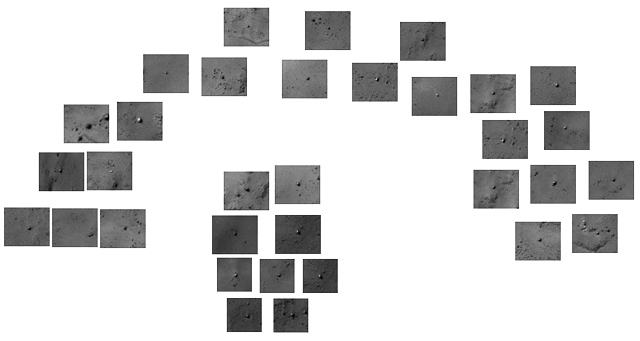
(The scale is reduced. ).
But there was not enough time and effort to search. I never finished the scheme, and, as it turned out later, the radius I had planned didn’t include landing elements - our device “scattered” stronger than the American ones.
In my search and Martian interests, I went to the Canadian scientist Philip J Stooke . At one time, he was looking for (but mistakenly identified) Lunokhod-2 in LRO images. He suggested the most important point, which turned out to be decisive - the direction of flight of the descent module. He said: "The flight went east." This made it possible to immediately cut off 50% of the unnecessary field and concentrate searches in the optimal direction.
I identified a sector that covered four times the radius than the American experience showed, and continued to methodically review the frame. It took several evenings, and, to be honest, I was already desperate to find something, and I continued simply out of the desire to finish the job. When I announced a mass search, I actually made a commitment that the efforts of people would not be wasted (although I warned that the probability of detection is extremely small ). In any case, I had to check to say with confidence “Find impossible” or “Found!” The
result was “Found!”.
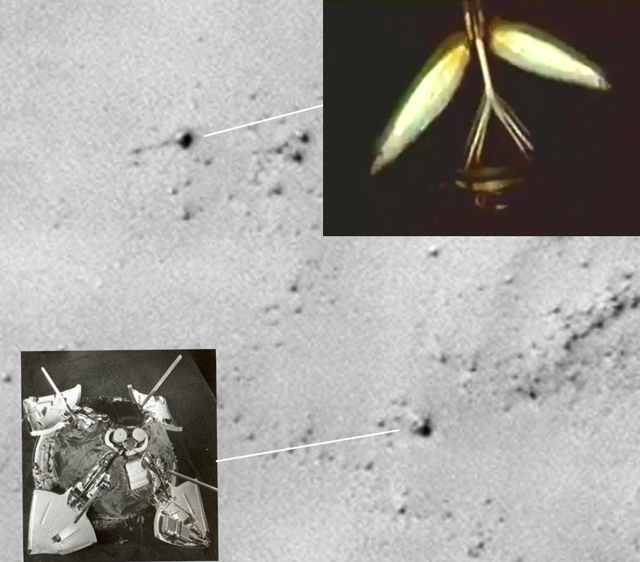
Initially, I concentrated my searches on the module, which was to be determined by its cross-shaped “petals”. From them I just identified this object. And the soft-landing engine, coupled with the parachute container that was found nearby, turned out to be a valuable bonus. I was based on the film, and there this detail "disappears" before landing, so I did not look for it. In fact, the final stage took place in the following sequence:
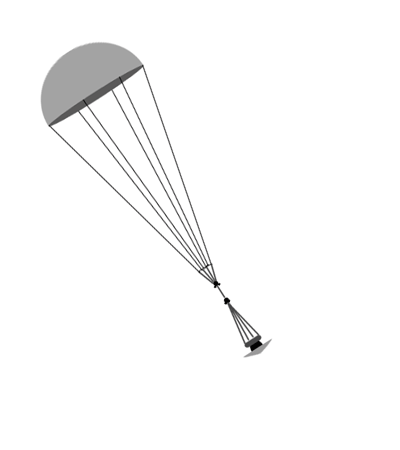
So, I found it! But what's next?
I could write about it on Habré or write on the same forum "Cosmonautics News", but there are already enough such searchers who see Mars-3 in every bump, and a parachute in every sand dune. Evidence was needed.
Here again Phil Knock helped. He looked at my find, agreed that it was very interesting, and advised to identify several more objects in the vicinity that are similar in size and shape to a descent module. This had to be done in order to show that my find was the most convincing.
I did this, and I got such a sheet: ( Clickable. 1 mb ) More precisely, there were two of them, but I think one example is enough. Under the first number is Mars-3 itself (the most convincing candidate). Of course, this sample is not entirely representative, since it was compiled when I already knew the correct answer, but I tried to select the most similar ones. Fortunately, there were no large heaps of stones, as in the photo above, in the search sector.

But this is only one argument in favor of my find. It was necessary to find more convincing evidence, but I could no longer do it myself. It was necessary to take a second shot of the area at another time of the day in order to determine the shape of the objects by the nature of the change in shadow. It was necessary to obtain information on the length of the cable that connected the parachute container and the soft landing engine. The last moment could not only confirm, but also refute my guess, which is in good agreement with Popper's criterion , which all scientific theories must meet. The length that is observed in the picture corresponds to 4.8 meters. If there were a discrepancy of at least a meter, then the honor of the discoverer could be forgotten.

This raises the question: how could a thin cable be visible in images with detail of 25 cm per pixel?
If you look at the Opportunity photo, you can see the shadow from its mast.

Although in reality its thickness does not exceed 15 cm:
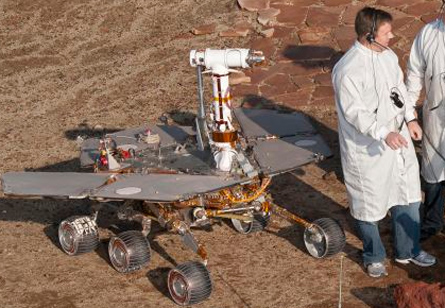
i.e. HiRise even sees what it should not.
However, it’s difficult to imagine even a 15 cm cable in this role, but I thought that sand could be placed along it, and we do not see the cable, but a small ridge that arose along it under the influence of the wind. Further research showed that even such assumptions are not necessary.
HiRise shot this section only once, and there are no information on the length of the cable in a few open sources. The most informative source is the book The Hard Road to Mars"V.G. Perminova (by the way, published using NASA funds and in English). But there wasn’t any necessary information there either.
Therefore, I turned to the professor, head of the laboratory of comparative planetology at the V.I.Vernadsky Institute of Geochemistry and Analytical Chemistry (GEOCHI) Alexander Bazilevsky . He was mentioned on Wikipedia in an article about Lunokhod-2, so I thought that he would be interested in the Martian theme. At first he was skeptical: "you need arguments - why do you think that this object is what you think. The argumentation used by one of my acquaintances: the Blind man who does not see this, does not pass here. "
I prepared a diagram on which I displayed everything that I" see "and as I see:
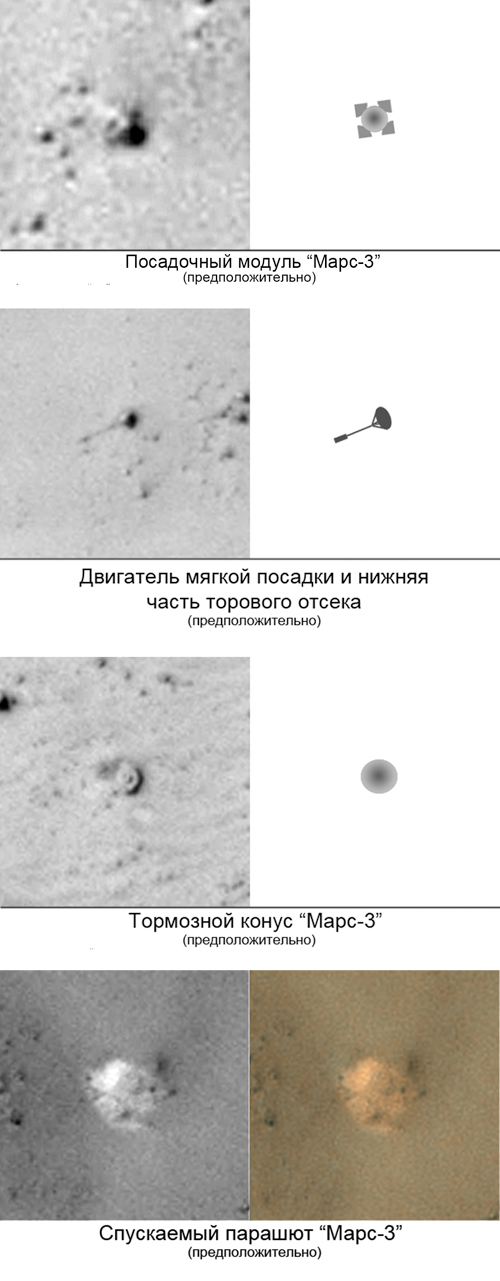
And he convinced me! Of course, like any scientist, Alexander Tikhonovich emphasized his doubts and always indicated in his correspondence "the elements of Mars-3, as Vitaly saw it." But at the same time he wrote to the head of the scientific group of the HiRise camera Alfred McEwan .
The American's response was quick and unexpected for me: "We will re-image this location to see if we can learn more."
Like this! I don’t know whether my illustrations were so convincing, or Bazilevsky’s international authority is so high that, according to the first appeal, NASA agreed to adjust the device’s operation in Martian orbit to shine into the place where something seemed to a simple boy from the Soviet Russia.
While NASA was aiming, Bazilevsky “infected” my findArnold Selivanov , head of the scientific and technical center of the RCC and one of the creators of Mars-3. He also quickly overcame initial skepticism and made an effort to double-check the information on his part. It was necessary to establish the length of the notorious cable on a soft landing engine. This could only be done by sneaking into the bowels of an NGO named after Lavochkina. With the filing of Selivanov, one of the engineers of the NGO, Vladimir Molodtsov, set off for this feat .
For me, there was a lull in this matter: HiRise plows near-Martian open spaces, Vladimir - open spaces of the NGO Lavochkina.
Trying to extract at least some information from the available photo, I calculated the height of the proposed module based on the length of the shadow and the angle of illumination. It turned out 78 cm. The actual height of Mars-3 is 75 cm (the ratio of height to width in the unfolded state is 1/2). A small argument in plus, but the main evidence had to wait.
Weeks passed, April was approaching.
The first news came from our side, from Vladimir: "The chains connecting the soft landing rocket propeller with a parachute container are 4.52 meters long. "
Bingo! 4.8 on Mars, 4.5 in the drawings. Accuracy within 1.5 pixels. Moreover, the visible 0.3 m is just suitable for the engine. It was just a great gift. We hastened to share it with the Americans, and in response we received no less positive news:We have a new image and are working on special noise removal and sharpening of both images .
A few days later they sent the finished result: ( Clickable. 3 mb ) By the way, the image they received was lower in quality than the 2007 frame due to the higher amount of dust in the atmosphere, but the color field of the camera captured the module itself. However, this did not give us any color information, because if it had been painted in any color, then the paint would have discolored under ultraviolet rays, and the surface was covered with a layer of dust. But now we can compare "it was-it was" and look at the field from different angles of illumination. New pictures also look paler because the sun is higher at its zenith, the shadows are shorter and everything seems flatter.

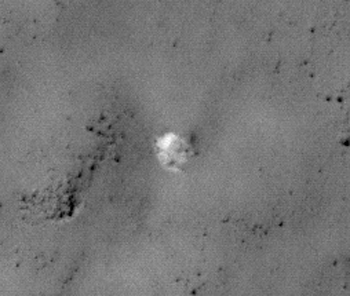
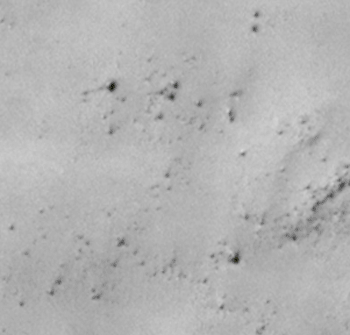
Then we agreed on a press release for another week. This, by the way, still emphasizes the ethics of NASA - they could write on their own, at least with a mention of us. However, perhaps these are simply international principles of cooperation. Unfortunately, they could not post the names of everyone who helped me in my searches on the NASA website, but did it on the NASA JPL website .
The result of our activities, searches, evidence and archival excavations - on the NASA website .
And now about the case: Mars-6 has not yet been found!
I would like to invite readers to contribute to the history of Russian cosmonautics. One could rush the crowd to the Hirise website, review the pictures and find something suitable. But more effective, from the point of view of popularization, would be to make an application on Android and iOs, which would allow you to view individual fragments of images and highlight the most interesting areas. Something like the Fourth Planet project . And where if not to apply to Habr with such ideas? I figured that one shot of 25Kpix by 80Kpix will give 8333 fragments of 600x400pix. And for Mars-6 there are several such shots, so that's enough for a long time. I think if you make such an application, then it will come in handy for searches of the American Mars Polar Lander and the European Beagle 2.
In the end, than throwing birds at pigs, it’s better to look for lost space stations! I will try to attract any support from Roskosmos, if anyone at all is thinking about popularization, or even NASA. Let's open a separate thread on the topic in the comments and discuss the details.
And, yes, none of this would have happened if it weren’t for my employers who called to Mars and turned a blind eye to the working hours that I spent buried in the gray field of the HiRise image.
And all with Cosmonautics Day!
UPD: here is a video lecture on the same topic .
We were looking for Mars 3 .
And we found him! Right on Mars, at the bottom of the giant Ptolemy crater, among lifeless wastelands and boulders.
About how we did this, today's story.

It all started on Habré ...
No, it began, of course, on May 28, far 1971, when the Soviet research station Mars-3 started to Mars. But for me personally, it all started on Habré in late November 2012, with one half-joking comment about NASA: “They found the old Soviet rover there ...” At that time, I was sure that all the “old rovers” were found long ago, because the places of their landings are known. But to test my knowledge, I went to the HiRise websiteand was surprised to learn that nothing was found! That is, the location of all successful devices is known, and they are all photographed by a HiRise camera on the NASA Mars Reconnaissance Orbiter satellite with a detail of 30 cm per pixel. But the situation with fails is not so clear. The Americans dropped Mars Polar Lander on Mars, the Europeans dropped Beagle 2, the USSR dropped Mars-6 and Mars-2, and none of this was found, although they were looking for it. But what about Mars-3? It turned out that no one had seen him either.
Our device, which made a phenomenal, first-ever successful landing on Mars 40-odd years ago! He proved that it was real, and he did it in almost the same sequence in which in 2012 the Americans put Curiosity. In general, see for yourself:
( I love this video. After all, they could launch a ship and make a movie )
So, Mars-3 sat successfully - this is known for sure, because he began the broadcast, and it is impossible without the antennas that have opened. But after 14 seconds, the radio broadcast was interrupted, leaving a puzzle for the designers about the reasons for the shutdown, and the first photograph of Mars in history was given to space and Photoshop enthusiasts.
What they just didn’t do with it, what filters they didn’t apply, just to play along with your imagination and examine the horizon, mountain slopes and Martian clouds or clouds of dust from the storm that was raging then.

But the whole trick is that it is part of the photo panorama, and to view it from the angle that the camera shot, this frame must be rotated 90 degrees. According to the designers, the photo should have turned out like this:

( This is a shot from the Moon-9, which has a lot in common with Mars-3 )
That is if you superimpose one on the other, it will look like this:

In general, valuable information was not transmitted from the surface, the first Mars rover did not set foot on the surface of Mars, because fastened to the top of the module, but a psychological victory was achieved - they first planted their device on another planet! The reason for the shutdown was not determined. Someone suggests a corona discharge in the antennas and sins in a storm, someone suspects a battery. In general, future settlers will have something to do.
Then there were other expeditions, other successes and failures, and the metal “flower” gradually went into oblivion. Generations and states have changed, the Internet, Habr and vkontakt appeared. And my interest in Mars-3 appeared.
Turning to the HiRise website, I only found a 2007 shot called Center of Soviet Mars 3 Landing Ellipse . This was a discovery for me, because I was so sure of the omnipotence of NASA and HIRise that I expected to see the exact indication of where our station was. A cursory search on the net also failed. Those. it was obvious that Mars-3 was never found. I downloaded a full-size snapshot (1.3 GB), opened it and realized why no one had found the station in 5 years.
Imagine a search on a 6 by 20 rectangle of a rounded object 1.5 meters wide. I know that many people now thought that it was necessary to write a program that would itself be looking for a station. But I think such a search is impossible until artificial intelligence is created. Yes, the program could highlight interesting boulders of the appropriate size.
But there are thousands of such objects, since there is a crater nearby, from which the rock scattered like a fan.

2 billion pixels, among which you need to find an 8 by 8 pixel object.
Here is a fragment in its original size:

I looked at the volumes of work and realized that there is no way to do without a collective mind. By then, in the VK group " Curiosity - Mars rover"there were already about 4 thousand people, and I suggested the subscribers a space-patriotic quest: find Mars-3. To do this, I cut a large photo into 20 strips, uploaded them to the network and invited everyone to participate in the search. More than a dozen enthusiasts responded they began to view the pieces and loaded into a separate album, the most interesting findings was found a lot of curious, but not an exact match showed none:.

Thanks to its location and shape of the object in the lower right corner with some confidence can be called bremsstrahlung cone or at NASA terminology - the heat shield agreed with it, and the Americans with the caveat "best candidate we still did not find" He was found two members of the search:.. a reply zaero Ya andAku Neko .
As soon as we started searching, people were found more sophisticated in googling and they quickly found a link on the forum "Cosmonautics News" topic, in which the user Imhotep posted a fragment of the picture, which, most likely, shows the parachute of Mars-3.
 .
. But we finished viewing the entire field of the image, but Mars-3 itself was never found. For verification, I placed all the interesting finds on a small-scale map to understand if there is any connection between them. And almost everything is past. Only the parachute and the brake cone coincided relatively, but then I did not attach any importance to this.
Then I decided to "dance from the stove" and concentrate on the parachute. That is, I took as a basis the hypothesis that it is he who is. The problem with the searches was that I did not know to what radius the structural elements could fly. Therefore, I took materials on American missions: Viking-1-2, Phoenix Lander, Mars Pathfinder, put on the landing site of Mars-3 and plotted the maximum radius to which NASA devices flew from my parachute. I brought out the most interesting objects to a separate scheme, where I placed them in approximate accordance with their position on the ground. The result was this picture:

(The scale is reduced. ).
But there was not enough time and effort to search. I never finished the scheme, and, as it turned out later, the radius I had planned didn’t include landing elements - our device “scattered” stronger than the American ones.
In my search and Martian interests, I went to the Canadian scientist Philip J Stooke . At one time, he was looking for (but mistakenly identified) Lunokhod-2 in LRO images. He suggested the most important point, which turned out to be decisive - the direction of flight of the descent module. He said: "The flight went east." This made it possible to immediately cut off 50% of the unnecessary field and concentrate searches in the optimal direction.
I identified a sector that covered four times the radius than the American experience showed, and continued to methodically review the frame. It took several evenings, and, to be honest, I was already desperate to find something, and I continued simply out of the desire to finish the job. When I announced a mass search, I actually made a commitment that the efforts of people would not be wasted (although I warned that the probability of detection is extremely small ). In any case, I had to check to say with confidence “Find impossible” or “Found!” The
result was “Found!”.

Initially, I concentrated my searches on the module, which was to be determined by its cross-shaped “petals”. From them I just identified this object. And the soft-landing engine, coupled with the parachute container that was found nearby, turned out to be a valuable bonus. I was based on the film, and there this detail "disappears" before landing, so I did not look for it. In fact, the final stage took place in the following sequence:

So, I found it! But what's next?
I could write about it on Habré or write on the same forum "Cosmonautics News", but there are already enough such searchers who see Mars-3 in every bump, and a parachute in every sand dune. Evidence was needed.
Here again Phil Knock helped. He looked at my find, agreed that it was very interesting, and advised to identify several more objects in the vicinity that are similar in size and shape to a descent module. This had to be done in order to show that my find was the most convincing.
I did this, and I got such a sheet: ( Clickable. 1 mb ) More precisely, there were two of them, but I think one example is enough. Under the first number is Mars-3 itself (the most convincing candidate). Of course, this sample is not entirely representative, since it was compiled when I already knew the correct answer, but I tried to select the most similar ones. Fortunately, there were no large heaps of stones, as in the photo above, in the search sector.

But this is only one argument in favor of my find. It was necessary to find more convincing evidence, but I could no longer do it myself. It was necessary to take a second shot of the area at another time of the day in order to determine the shape of the objects by the nature of the change in shadow. It was necessary to obtain information on the length of the cable that connected the parachute container and the soft landing engine. The last moment could not only confirm, but also refute my guess, which is in good agreement with Popper's criterion , which all scientific theories must meet. The length that is observed in the picture corresponds to 4.8 meters. If there were a discrepancy of at least a meter, then the honor of the discoverer could be forgotten.

This raises the question: how could a thin cable be visible in images with detail of 25 cm per pixel?
If you look at the Opportunity photo, you can see the shadow from its mast.

Although in reality its thickness does not exceed 15 cm:

i.e. HiRise even sees what it should not.
However, it’s difficult to imagine even a 15 cm cable in this role, but I thought that sand could be placed along it, and we do not see the cable, but a small ridge that arose along it under the influence of the wind. Further research showed that even such assumptions are not necessary.
HiRise shot this section only once, and there are no information on the length of the cable in a few open sources. The most informative source is the book The Hard Road to Mars"V.G. Perminova (by the way, published using NASA funds and in English). But there wasn’t any necessary information there either.
Therefore, I turned to the professor, head of the laboratory of comparative planetology at the V.I.Vernadsky Institute of Geochemistry and Analytical Chemistry (GEOCHI) Alexander Bazilevsky . He was mentioned on Wikipedia in an article about Lunokhod-2, so I thought that he would be interested in the Martian theme. At first he was skeptical: "you need arguments - why do you think that this object is what you think. The argumentation used by one of my acquaintances: the Blind man who does not see this, does not pass here. "
I prepared a diagram on which I displayed everything that I" see "and as I see:

And he convinced me! Of course, like any scientist, Alexander Tikhonovich emphasized his doubts and always indicated in his correspondence "the elements of Mars-3, as Vitaly saw it." But at the same time he wrote to the head of the scientific group of the HiRise camera Alfred McEwan .
The American's response was quick and unexpected for me: "We will re-image this location to see if we can learn more."
Like this! I don’t know whether my illustrations were so convincing, or Bazilevsky’s international authority is so high that, according to the first appeal, NASA agreed to adjust the device’s operation in Martian orbit to shine into the place where something seemed to a simple boy from the Soviet Russia.
While NASA was aiming, Bazilevsky “infected” my findArnold Selivanov , head of the scientific and technical center of the RCC and one of the creators of Mars-3. He also quickly overcame initial skepticism and made an effort to double-check the information on his part. It was necessary to establish the length of the notorious cable on a soft landing engine. This could only be done by sneaking into the bowels of an NGO named after Lavochkina. With the filing of Selivanov, one of the engineers of the NGO, Vladimir Molodtsov, set off for this feat .
For me, there was a lull in this matter: HiRise plows near-Martian open spaces, Vladimir - open spaces of the NGO Lavochkina.
Trying to extract at least some information from the available photo, I calculated the height of the proposed module based on the length of the shadow and the angle of illumination. It turned out 78 cm. The actual height of Mars-3 is 75 cm (the ratio of height to width in the unfolded state is 1/2). A small argument in plus, but the main evidence had to wait.
Weeks passed, April was approaching.
The first news came from our side, from Vladimir: "The chains connecting the soft landing rocket propeller with a parachute container are 4.52 meters long. "
Bingo! 4.8 on Mars, 4.5 in the drawings. Accuracy within 1.5 pixels. Moreover, the visible 0.3 m is just suitable for the engine. It was just a great gift. We hastened to share it with the Americans, and in response we received no less positive news:We have a new image and are working on special noise removal and sharpening of both images .
A few days later they sent the finished result: ( Clickable. 3 mb ) By the way, the image they received was lower in quality than the 2007 frame due to the higher amount of dust in the atmosphere, but the color field of the camera captured the module itself. However, this did not give us any color information, because if it had been painted in any color, then the paint would have discolored under ultraviolet rays, and the surface was covered with a layer of dust. But now we can compare "it was-it was" and look at the field from different angles of illumination. New pictures also look paler because the sun is higher at its zenith, the shadows are shorter and everything seems flatter.



Then we agreed on a press release for another week. This, by the way, still emphasizes the ethics of NASA - they could write on their own, at least with a mention of us. However, perhaps these are simply international principles of cooperation. Unfortunately, they could not post the names of everyone who helped me in my searches on the NASA website, but did it on the NASA JPL website .
The result of our activities, searches, evidence and archival excavations - on the NASA website .
And now about the case: Mars-6 has not yet been found!
I would like to invite readers to contribute to the history of Russian cosmonautics. One could rush the crowd to the Hirise website, review the pictures and find something suitable. But more effective, from the point of view of popularization, would be to make an application on Android and iOs, which would allow you to view individual fragments of images and highlight the most interesting areas. Something like the Fourth Planet project . And where if not to apply to Habr with such ideas? I figured that one shot of 25Kpix by 80Kpix will give 8333 fragments of 600x400pix. And for Mars-6 there are several such shots, so that's enough for a long time. I think if you make such an application, then it will come in handy for searches of the American Mars Polar Lander and the European Beagle 2.
In the end, than throwing birds at pigs, it’s better to look for lost space stations! I will try to attract any support from Roskosmos, if anyone at all is thinking about popularization, or even NASA. Let's open a separate thread on the topic in the comments and discuss the details.
And, yes, none of this would have happened if it weren’t for my employers who called to Mars and turned a blind eye to the working hours that I spent buried in the gray field of the HiRise image.
And all with Cosmonautics Day!
UPD: here is a video lecture on the same topic .
